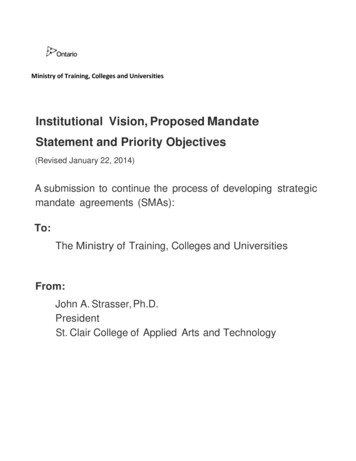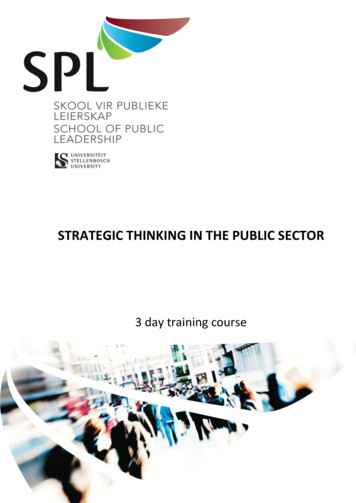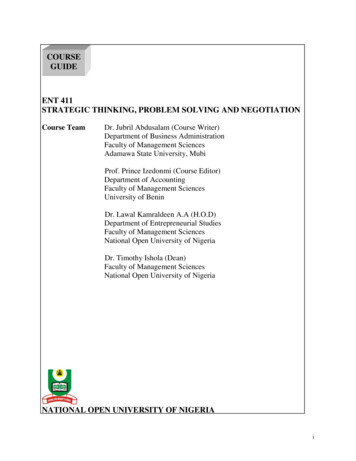
Transcription
Ministry of Training, Colleges and UniversitiesInstitutional Vision, Proposed MandateStatement and Priority Objectives(Revised January 22, 2014)A submission to continue the process of developing strategicmandate agreements (SMAs):To:The Ministry of Training, Colleges and UniversitiesFrom:John A. Strasser, Ph.D.PresidentSt. Clair College of Applied Arts and Technology0
This submission will continue the process of developing our Strategic Mandate Agreements that began with thesubmission of St. Clair College to the Honourable Glen Murray, Minister of Training, Colleges and Universities onSeptember 28, 2012.SECTION AINSTITUTIONAL MANDATE STATEMENT(Approved by the St. Clair College Board of Governors, September 25, 2012)St. Clair College is determined to establish itself as a "Destination College". By offering more degree programs,extending its scope of articulation agreements with universities and colleges within the province, nationally andinternationally and by establishing entrepreneurship, research and innovation partnerships the College willbroaden the ability of our students to acquire knowledge and leading-edge skills that will allow them to be animportant resource in a globally competitive marketplace, with unique program offerings, state-of-the-art facilities,and an operating philosophy founded on accessibility, quality teaching, learning method options andsustainability.MISSION STATEMENTSt. Clair College strives to create a respectful and welcoming educational environment that will: Assist individuals in developing skills, knowledge and values to support chosen careers, or supporttheir involvement in their community. Provide students with an accessible, dynamic and supportive learning environment which adapts totheir changing requirements for quality lifelong learning. Provide leadership and develop partnerships that support the ability of our community to compete in aglobal economic environment.VISION STATEMENT(Approved by the St. Clair College Board of Governors on January 15, 2002)Striving for excellence in all we do, St Clair College is accessible and responsive to its community.SECTION BIn developing the St. Clair College Strategic Mandate Priorities, four fundamental principles were followed: Build on our history and our established clusters of excellence. Address the educational requirements that our unique international location demands intransportation, border logistics and the health, hospitality and tourism needs of a region referred to as“Canada South”. St. Clair College is the southernmost post-secondary institution in Canada. Respond to the local community needs. Leverage our resources and partnerships.PRIORITY #1: HEALTH AND COMMUNITY WELLNESSSt. Clair College continues to build on our 45 year history of excellence in Health and Community Wellness. Ourbreadth of programming and student enrolment for this vocational cluster leads the college sector. The Ontariocollege sector summary enrolment data in Table 1 confirms that St. Clair College fall intakes for Health andCommunity Wellness programming is the highest in Ontario. The healthcare sector is a very important source ofemployment to extreme SW Ontario. In fact, Windsor-Essex has the second highest concentration of workers inthe health sector in Ontario. At the 2006 census, there were 625 people employed in health-related occupationsper 10,000 in the workforce which is well above the provincial level of 517 or the Toronto rate of ThisJustIn/2009/2009.02.10ThisJustIn.pdf1
With respect to the education of Registered Nurses, with average yearly intakes close to 200 students for ourB.Sc.N. program, St. Clair College has some of the largest B.Sc.N. intakes in the college sector as can be seen inTable 2. It is the intent of St. Clair College to continue to pursue government approvals to deliver the full B.Sc.N.program and to confer the degree.The sustained growth in our Health and Community Wellness programs is founded on our superior reputation inclinical learning, recent large investments in innovative teaching tools and our innovative co-productiverelationships. The 100 km radius around St. Clair College (including the University of Michigan Health System,William Beaumont Hospital and the Henry Ford Health System) is regarded as one of the premier health treatmentand biomedical research areas in North America. While the easy flow for placements into the U.S. has not yetreturned to pre September 11, 2001 levels, with our proximity to SE Michigan, St. Clair College is uniquelypositioned among the Ontario college sector to capitalize on the opportunities in these world-class healtheducation and hospital facilities. Our recent Biomedical Engineering Technology program submission to MTCU isa key element in a proposed Michigan partnership that leverages our expertise in health sciences and electromechanics to grow the nascent Windsor-Essex biomedical device industry to enter the US market.Table 2. First Semester Enrolment for CollegeB.Sc.N. 568St. eorgian124611361042967Humber194189184201George 55645Georgian107129115107Seneca614546532504George 1243253Durham--------St. Lawrence794712722767St. 4533536La 99Fleming--------Loyalist227251146208La 180221238Confederation--------EastGTAWest2012St. ClairNorthNorthEastGTAWestTable 1. First Semester Enrolment for CollegeHealth Science Programs2Programs included in database:Cardiovascular Technology, Dental Assisting, Dental HygieneDiagnostic Medical Sonography, Medical Laboratory Science,Medical Laboratory Technician, BScN, OTA/PTA, OA Medical,Paramedic, PSW, Pharmacy, Practical Nursing, Pre-Health,Respiratory Therapy, Gerontology, Health & Fitness Training2Ontario College Application Service (OCAS) data.2
Domestically, St. Clair College is a founding member of the Southwest Academic Health Network (SWAHN) alongwith Western University Schulich School of Medicine and Dentistry. In June 2009, St. Clair College signed aMemorandum of Understanding with the University of Windsor, Windsor Regional Hospital and Hotel DieuHospital to work jointly to address the health needs of the region. In Leamington and Essex County, St. ClairCollege is currently working with the Leamington Hospital and the Hospice of Windsor to provide an integratedfootprint for enhanced health care services in the Leamington-Kingsville Essex County area. St. Clair College hascreated an unique partnership with Schlegel Villages to build a long-term care facility on the St. Clair Collegecampus which is known as “The Village at St. Clair”.3 The facility will allow the integration of the learning processinto the operation of the facility in the form of clinical experience and experiential learning. As such, St. ClairCollege is committed to exploring the introduction of programming that trains highly qualified personnel (HQP) forthe long-term health care facility sector. This may include leveraging our expertise and facilities in CulinaryManagement for a proposed program in Dietetic Technician; and our programs in Occupational Therapy andGerontology for new programs in Massage Therapy and Therapeutic Recreation Technician. Additionally, theCollege will investigate the feasibility of partnering with the Western University Schulich School of Medicine andDentistry to introduce a joint Chiropodist Technology program which does not exist outside of the MichenerInstitute in Toronto. With modest government capital funding for a new speech and hearing laboratory, St. ClairCollege would consider introducing Hearing Technician and Communicative Disorders programs since hearingloss and stroke-induced speech problems are endemic in the aging population and in the large local populationwith an autism spectrum disorder.Related to our excellence in clinical training, St. Clair College has invested heavily in teaching technologies for theApplied Health Sciences. SWAHN has recognized our leadership role in robotic simulation for health careeducation in SW Ontario. We have worked with Western University Schulich School of Medicine and Dentistry toprovide simulation learning for their Windsor campus students. Going forward, the College is dedicated to usingtechnology to provide vocational post-graduate training to health care professionals. Therefore, St. Clair willinvestigate hybrid and on-line education for professional nursing upgrading such as critical care, operating room,perinatal, renal and endoscopic, as well as the Registered Practical Nurse to Registered Nurse Bridge.Additionally, there is an acknowledged regional need for the creation of bench-depth in health management andleadership. St. Clair College will study the viability of offering a distinctive Bachelor of Health Management andLeadership Degree especially designed for the working health professional.At both our Windsor and Chatham campuses over the past three years, St. Clair College has invested more than 35 Million to build the Centre for Applied Health Sciences Building in Windsor and the Mary Uniac HealthSciences Education Centre, in Chatham. These facilities have the newest histology, pathology, microbiology, andhematology laboratories, multi- media dental suites, dental materials laboratory, retail and hospital pharmacydispensary simulators, a 72 bed nursing instructional facility including multi-media simulation suites and sixspecialized patient care laboratory apartments. Additionally, we have added new programming and laboratoriesin Cardiovascular Technology, Respiratory Therapy, Ultrasound, Paramedics and Occupational Therapy. Whencapital money is available and with the support and co-operation of the Local Health Integration Network (LHIN)and health services delivery network, St. Clair College will provide vocational training in Renal Technician sinceWindsor-Essex and Chatham-Kent has the highest rates of diabetes and renal dysfunction in Southern Ontario.Finally, our Centre for Applied Health Sciences Building is pedagogically unique. As a single purpose facility, theApplied Health Sciences Building resembles a hospital, and the curriculum incorporates inter-professional andcross-disciplinary learning experiences. A facility where nursing, paramedic, medical laboratory, pharmacy,respiratory therapist, ultrasound technologists, and cardiovascular technicians can all interact and learn togetherdoes not exist elsewhere in the Ontario college system. Further, the College is committed to offeringprogramming in the emerging cross-disciplinary academic areas especially where there are synergies withexisting clusters of excellence. Therefore, St. Clair will consider the introduction of a new bachelor program inAthletic Therapy and Exercise Science which bridges our established expertise in health sciences together withour new 25 Million state-of-the-art SportsPlex.With respect to research in the health sciences, St. Clair College has partnered with Schlegel Villages and TheUniversity of Waterloo Schlegel Institute for Research into Aging.In the related Wellness programming, St. Clair College has strong and extensive ties to the Windsor-Essex andChatham-Kent communities. For example, St. Clair College was the first college to offer a Child and Youth3The Schlegel Group builds and operates a continuum of care facilities for older adults, including long-term care and retirement homes acrosseleven Ontario locations.3
Worker (CYW) diploma program. Our CYW program differs from most other college programs because of theemphasis on clinical experience through our long-established network of community partners. Today, this Collegeoffers CYW at both campuses and in a variety of delivery formats. It is the intent of St. Clair College to cover theentire spectrum of CYW credentials. Therefore, St. Clair College intends to mount a bachelor program in CYW.Like the CYW program, our Developmental Services Worker (DSW) program was established to provide HQP forSouthwestern Ontario Regional Centre in Cedar Springs. Today, DSW is offered in delivery formats similar toCYW. Going forward St. Clair College will study the needs of the local community for such programs asCommunity Integration through Co-operative Education (CICE), Community Mental Health Worker, Social WorkerDiploma, and Social Worker for Immigrant Populations Diploma. The latter is particularly important as WindsorEssex is the 4th most culturally diverse city in Canada.In addition to the chronic diseases of aging and lifestyle, the prevalence of the autism spectrum disorders inWindsor-Essex is among the highest in North America. Leveraging on the strength and reputation of our Autismand Behavioral Science Program, St. Clair College will study the viability of creating an Autism Respite, Researchand Learning Centre to work with autistic children and their caregivers on an 11 acre rural site donated to St. ClairCollege in 2011. Preliminary studies indicate this initiative will cost 1.25 Million. The Autism Respite, Researchand Learning Centre is St. Clair College third priority for capital funding.Additionally, St. Clair College will introduce in September 2014 a new CICE (Community Integration through Cooperative Education) program which provides adults with developmental challenges the opportunity to experiencecollege life.For Priority #1 Health and Community Wellness, the following metrics are proposed: Metric 1.1: Overall retention rates as reported in the MYAA report back. Metric 1.2: For under-represented groups, including those students with disabilities, aboriginalstudents, and first-generation students, development of tracking tools to measure retention rates,graduation rates, and program duration/completion time. Metric 1.3: Student satisfaction as captured in KPI’s (#14, #26, #44, and #45). Metric 1.4: Maintenance of leadership position in student satisfaction for tutoring services. Metric 1.5: Target enrolment within program areas of strategic focus. Metric 1.6: Creation of an Autism Respite, Research and Learning Centre.PRIORITY #2: INTERNATIONAL MANUFACTURING AND TRADEThe Windsor-Detroit border crossing is the busiest cargo crossing between Canada and the United Stateshandling over 26% of all trade between the two countries. In addition, the south side of the Detroit River isconsidered the busiest international waterway in the world. More than 800 Windsor area manufacturers are withinone day trucking distance to 90% of North American automobile assembly plants.No other urban center in Canada comes close to Windsor-Essex for employment concentration in cross borderand logistics. In fact in 2006, the rate of employment in the international trade sector in Windsor-Essex is more4than three times the rate for Ontario. With the announcement of a new Fedex facility at Windsor airport, thecontinued accelerated development of Windsor as an inter-modal transportation hub is forecasted.5Even after the recent recession, Windsor-Essex is still the most manufacturing intensive region in Canada wherealmost 20% of all employed persons in the region worked in the manufacturing sector. 6 As an example of theimportance of manufacturing, the Machine, Tool, Die and Mold sub-sector has been conservatively estimated as a 10.5 Billion economic impact to Ontario.7 Manufacturing today in Windsor-Essex includes information technologyand micro-electronics. Examples include computer numerical control (CNC), computer-integrated manufacturing(CIM), robotics, automation and visioning systems, and advanced methodologies like lean manufacturing.Considered pioneers and leading edge, the manufacturing sector centered in Windsor-Essex has gainedinternational recognition throughout the automotive sector, and in agriculture, aerospace and the pharmaceuticaland healthcare industries. However, as the global manufacturing economy becomes more integrated andcompetitive, efficiency and safety in cross border logistics and supply chain management becomes a critical4Statistics Canada 1996 and 2006 Censuses using the 1991 Standard Occupation Classification.Windsor Essex Economic Development Corporation, Discover our Region’s Growth, Prosperity and Sustainability, (Feb 2011).6Statistics Canada, Canadian Business Patterns (June 2009).7Windsor Essex Economic Development Corporation, Discover our Region’s Growth, Prosperity and Sustainability, p41 (February 2011).45
element in the economic prosperity of Windsor-Essex since, as an example, more than 84% of the vehicles built inCanada are exported.With respect to research and innovation in manufacturing, St. Clair College has a state of the art, 100,000 ft 2 FordCentre for Excellence in Manufacturing which has been recognized internationally with the prestigious Yves8Landry Award of Excellence. Furthermore, St. Clair College is a founding member of the CONII (CollegesOntario Network for Industry Innovation).There is no other region in Ontario where the significance of the border is as great and where the efficient andsafe flow of materiel and product for the manufacturing sector are as critical to the economic prosperity of thewhole of Ontario. Locally, the demand for highly qualified personnel (HQP) in the global-oriented manufacturingsector and in the associated supply chain management and logistics is robust and growing. In 2006, thepercentage of people employed as customs agents and brokers in Windsor-Essex was three times the numberemployed in Toronto, Vancouver and Montreal.4St. Clair College believes that the establishment of a Centre for Cross Border Logistics and Security(CCBLS) is acritical and strategic element in the trajectory of the development of the Windsor-Essex area and will continue St.Clair College on a path as a center of excellence in logistics and supply chain and border management. As aninitial step, in October 2011, St. Clair College signed an MOU with the University of Windsor and the City ofWindsor to work together on projects related to the border security and logistics. The essence of that agreementis captured in the figure below. At the high level, within the CCBLS there is a distinction between the expectedoutcomes of the University of Windsor and St. Clair College. The former will focus more on policy issues andfundamental research while St. Clair will focus on meeting the human resource needs of the industry together withindustry driven applied research.Centre for Cross Border Logistics and Security – Windsor, CanadaMember Institute of the International HOLM* NetworkCanada’s premier location for cross-border logistics,education and research.Safe & EfficientBorderBaseGlobal Trade Supply Chain Distribution ChainPolicies &InfrastructureCSRCommunity SocialResponsibilityResearch &TechnologyBCMBetter CostManagementMindsetsEducation &CertificationPPIProtect PeopleandInfrastructureStrategic ThrustsHREHuman ationVision Information Chain Authority Chain*House of Logistics and MobilityFrankfurt, GermanyCurrently St. Clair College is the largest source of HQP for the cross-border logistics and security sector inOntario. With programs ranging from Border Services Agent, International Trade Management, and BusinessAdministration for International Trade, St. Clair College supplies about 200 HQP to the region each year. Forexample, from 2009 to 2012 the cumulative intake for the Border Services program at St. Clair College was 554versus 381 for the remainder of the college system.9 With the introduction of the Centre for Cross BorderLogistics and Security, it is anticipated that St. Clair College will be able to increase HQP to approximately 300 intwo years, and to 450 within five years. The anticipated cost to create the St. Clair College Centre for Cross89www.yveslandryfoundation.comOntario College Application Service data.5
Border Logistics and Security is 3.2 Million. For capital funding, the Centre for Cross Border Logistics andSecurity is the second priority for St. Clair College.In the long term planning for St. Clair College, a Centre for Cross Border Logistics and Security would have atwofold mandate for St. Clair College. First, the CCBL could provide a range of unique educational programmingunder an umbrella signature program such as a Bachelor of Supply Chain Management and Logistics degreewhere students could earn industry recognition (i.e. Certified Production Inventory Manager (CPIM), CertifiedSupply Chain Professional (CSCP), and Canadian Institute of Traffic and Transportation (CITT) designations).Specialized corporate training that addresses the needs in international trade will add to the College contributionto local industry.Working closely with the federal, provincial and municipal governments and institutions, and industrial partners,CCBL would provide the intellectual hub in SW Ontario for improving the efficiency and productivity of crossborder logistics and security through the reduction of technical and organizational inefficiencies via simulation,computer modeling, on-site consulting services, and through the introduction and adoption of new technologies,processes, materials and services. Spearheaded by the Farrow Group, one of the most significant andcomprehensive broker and logistics companies in North America, there are over 30 Windsor-Essex wholesaletrade agents and brokers who have offered their strong endorsement and support for the CCBL initiative. RickFarrow, an Alumni of Distinction of St. Clair College continues to support College initiatives and the expertise ofthe Farrow Group is available to the College.For Priority #2 International Manufacturing and Trade, the following metrics are proposed: Metric 2.1: Overall retention rates as reported in the MYAA report back. Metric 2.2: For under-represented groups, including those students with disabilities, aboriginalstudents, and first-generation students, development of tracking tools to measure retention rates,graduation rates, and program duration/completion time. Metric 2.3: Maintenance of leadership position in student satisfaction for tutoring services. Metric 2.4: Student satisfaction as captured in KPI’s (#14, #26, #44, and #45). Metric 2.5: Target enrolment within program areas of strategic focus. Metric 2.6: Creation of a Centre for Cross Border Logistics and Security.PRIORITY #3: CREATIVE ARTS, HOSPITALITY AND TOURISMThe important connection between creativity, innovation, and arts and economic development is welldocumented.10 Not only do the arts attract and retain knowledge workers, but they contribute to the tourism andhospitality sector. The most important benefit of tourism is the increase in opportunities for a diversified economywhile holding to the characteristics that make extreme SW Ontario special. For example, the Ministry of Tourismin 2010 estimated the economic impact of tourism for Essex County as more than 1 Billion to the local GDP andover 18,400 direct, indirect and induced jobs (about 12% of the local workforce).11Over the past decade, St. Clair College has strategically invested in programming and acquired physicalinfrastructure in the broad area of creative and design arts, hospitality and tourism. St. Clair College was at thevanguard of the economic revitalization of downtown Windsor seven years ago when the College acquired the200,000 ft2 former Cleary Convention Centre (now re-branded as the St. Clair College Centre for the Arts SCCCA)which was a multi-purpose convention, catering and live theatre operation. This acquisition allowed the College tointegrate a working facility into our academic learning process. The theatre was the springboard to launch ourhighly regarded Music Theatre Performance program and the one Entertainment Technology program in Ontario.The College has since acquired a second theatre in Chatham. The College used federal investment to create thestand-alone MediaPlex in downtown Windsor. The Mediaplex is the only multi-platform journalism learning facilityin Canada. The MediaPlex technology is also used extensively in the recently introduced Public RelationsDiploma program. The Hospitality, Tourism and the new Event Planning programs are located at the SCCCAwhere students are instructed through real practical placements at the facility. Additionally, students in theseprograms can be placed at Woodland Hills Golf Club which the College acquired in 2013. Culinary Managementstudents also work in the catering business associated with the SCCCA. Our Travel and Tourism Program haspartnered with Central Michigan University and Disney as the only Ontario college with co-op placements at1011Richard Florida, Rise of the Creative Class Revised Edition, Perseus Books (2012).Ontario Ministry of Tourism, The Economic Impact of Tourism Jobs in Essex County in 2010 Using the TREIM Analysis, (April 2010).6
Disney World in Florida.Within the hospitality and culinary suite of programs, St. Clair College has teamed with the Ontario Ministry ofAgriculture and Rural Affairs (OMAFRA) to create a specially designed teaching bakery in downtown Chatham.There is a proposal before MTCU requesting permission to deliver a new Baking and Pastry Arts Managementprogram at this new facility.The tourism and hospitality industry sector has been identified as a major element of the Windsor-Essexeconomic map.12 With two of Ontario’s four designated appellations of origin, the wine industry in the St. ClairCollege census area provides 400 jobs ( 5 Million in direct wages and salaries), and retail sales of about 15Million. In the 30 years since viticulture was re-established in extreme SW Ontario, the wine industry in Essex andPelee Island has grown to more than 20 wineries. In 2012, Pelee Island and Essex County wineries produced1,232,700 (9 litre cases) compared to the Niagara region 1,325,430 (9 litre cases).The wine industry is the basis of the surge in agri-tourism locally. The wine sub-sector contributes 160 Million,including economic multipliers, to the region and continues to increase with associated job growth.13St. Clair College proposes to create The Canada South Culinary and Wine Institute. The Canada South Culinaryand Wine Institute positions St. Clair College to accommodate planned enrolment growth to meet the anticipatedpersonnel needs of the local industry and the Institute will give workforce entrants and re-entrants a broader rangeof education and training opportunities. Over the 1996 to 2006 period, there was a 21% increase in the number ofchefs and cooks employed in the Windsor-Essex workforce, while for the same period there was a 15% rise in therest of Ontario.14 The Canada South Culinary and Wine Institute is conceived as a state-of-the-art 30,000 ft2facility incorporating teaching facilities for back-of-the-house (i.e. kitchens and laboratories) and front-of-the-house(i.e. restaurant, banquet areas, wine tasting) activities. The Institute is a key element in the College analysis ofwhether to introduce a suite of programs related to tourism, culinary and agri-business including proposedprograms like the Bachelor of Hospitality Management and a Viticulture and Enology Diploma. The anticipatedcost of the Culinary and Wine Institute is 7.9 Million. For capital funding, the Culinary and Wine Institute is thefirst priority for St. Clair College.Design and technology programs at St. Clair emphasize practical product design and local labor market demand.In 2013, the College invested close to 1 Million to create dedicated design and studio space for a new program inFashion Design. This program joins a strong program mix ranging from Auto Product Design, Graphic Design,Web Design, Architectural Design, Landscape Design and Interior Design. As the entry-to-practice for InteriorDesign will change to the bachelor degree, St. Clair College is committed to offering this degree. Building on thecurrent strength in Auto Product Design, the College will investigate a degree in Industrial Design. And, St. ClairCollege with cluster-of-excellence in IT related fields like graphic design, web design, animation and networkingwill introduce a Mobile Applications Development program which is presently before the MTCU for approval. TheCollege has, since 2006, leveraged Cisco curriculum and certification in both the Computer Systems Technology Networking program and the Computer Systems Technician – Networking program.For Priority #3 Creative Arts, Hospitality and Tourism, the following metrics are proposed: Metric 3.1: Overall retention rates as reported in the MYAA report back. Metric 3.2: For under-represented groups, including those students with disabilities, aboriginalstudents, and first-generation students, development of tracking tools to measure retention rates,graduation rates, and program duration/completion time. Metric 3.3: Student satisfaction as captured in KPI’s (#14, #26, #44, and #45). Metric 3.4: Maintenance of leadership position in student satisfaction for tutoring services. Metric 3.5: Target enrolment within program areas of strategic focus. Metric 3.6: Creation of a Culinary and Wine s/all/themes/weedc/documents/data regional economic roadmap.pdfWindsor Economic Development Corporation, 2012 Wine Report, (March 2012).1
Athletic Therapy and Exercise Science which bridges our established expertise in health sciences together with our new 25 Million state-of-the-art SportsPlex. With respect to research in the health sciences, St. Clair College has partnered with Schlegel Villages and The University of Waterloo Schlegel Institute for Research into Aging.











